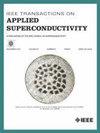Resistance of High-Temperature Superconducting Tapes Triggered by Alternating Magnetic Field
IF 1.8
3区 物理与天体物理
Q3 ENGINEERING, ELECTRICAL & ELECTRONIC
引用次数: 0
Abstract
Dynamic resistance occurs in a superconducting tape carrying a dc transport current while being exposed to an alternating magnetic field. This effect is caused by flux movements interacting with the transport current. The dynamic resistance is already applied in many superconducting applications, for example, superconducting flux pumps or persistent current switches. The resistance is highly dependent on the magnetic field and the frequency the superconductor is subjected to and its properties. When the dynamic resistance exceeds a certain value and, thus, enters the magnitude of the resistances of the normal conducting layers of the high-temperature superconducting (HTS) tape, these normal conducting layers play a significant role in the total resistance of the tape. In this article, modifications were made to the silver stabilizer, and the total resistance of the HTS tape has been investigated. The experimental results with frequencies up to 1000 Hz and magnetic field up to 277 mT show significant increases in resistance. In addition, a multilayer model based on H-formulation is presented to calculate the losses of the superconductor. The results also show significant heating due to the losses and, therefore, a temperature rise, which affects the measured total resistance. These results can be further used for applications, where high switchable resistances are required with zero dc resistance when the magnet is turned交变磁场触发高温超导带的电阻
动态电阻发生在携带直流传输电流的超导带暴露在交变磁场中。这种效应是由通量运动与输运电流相互作用引起的。动态电阻已经应用于许多超导应用中,例如超导磁通泵或恒流开关。电阻高度依赖于磁场和超导体所受的频率及其特性。当动态电阻超过一定值,从而进入高温超导(HTS)带的正常导电层电阻的量级时,这些正常导电层对带的总电阻起着重要的作用。本文对银稳定剂进行了改性,并对高温超导胶带的总电阻进行了研究。实验结果表明,当频率高达1000 Hz,磁场高达277 mT时,电阻显著增加。此外,提出了一个基于h公式的多层模型来计算超导体的损耗。结果还显示,由于损耗和温度上升,显著加热,从而影响测量的总电阻。这些结果可以进一步用于应用,其中高开关电阻需要零直流电阻时,磁铁关闭。
本文章由计算机程序翻译,如有差异,请以英文原文为准。
求助全文
约1分钟内获得全文
求助全文
来源期刊

IEEE Transactions on Applied Superconductivity
工程技术-工程:电子与电气
CiteScore
3.50
自引率
33.30%
发文量
650
审稿时长
2.3 months
期刊介绍:
IEEE Transactions on Applied Superconductivity (TAS) contains articles on the applications of superconductivity and other relevant technology. Electronic applications include analog and digital circuits employing thin films and active devices such as Josephson junctions. Large scale applications include magnets for power applications such as motors and generators, for magnetic resonance, for accelerators, and cable applications such as power transmission.
 求助内容:
求助内容: 应助结果提醒方式:
应助结果提醒方式:


